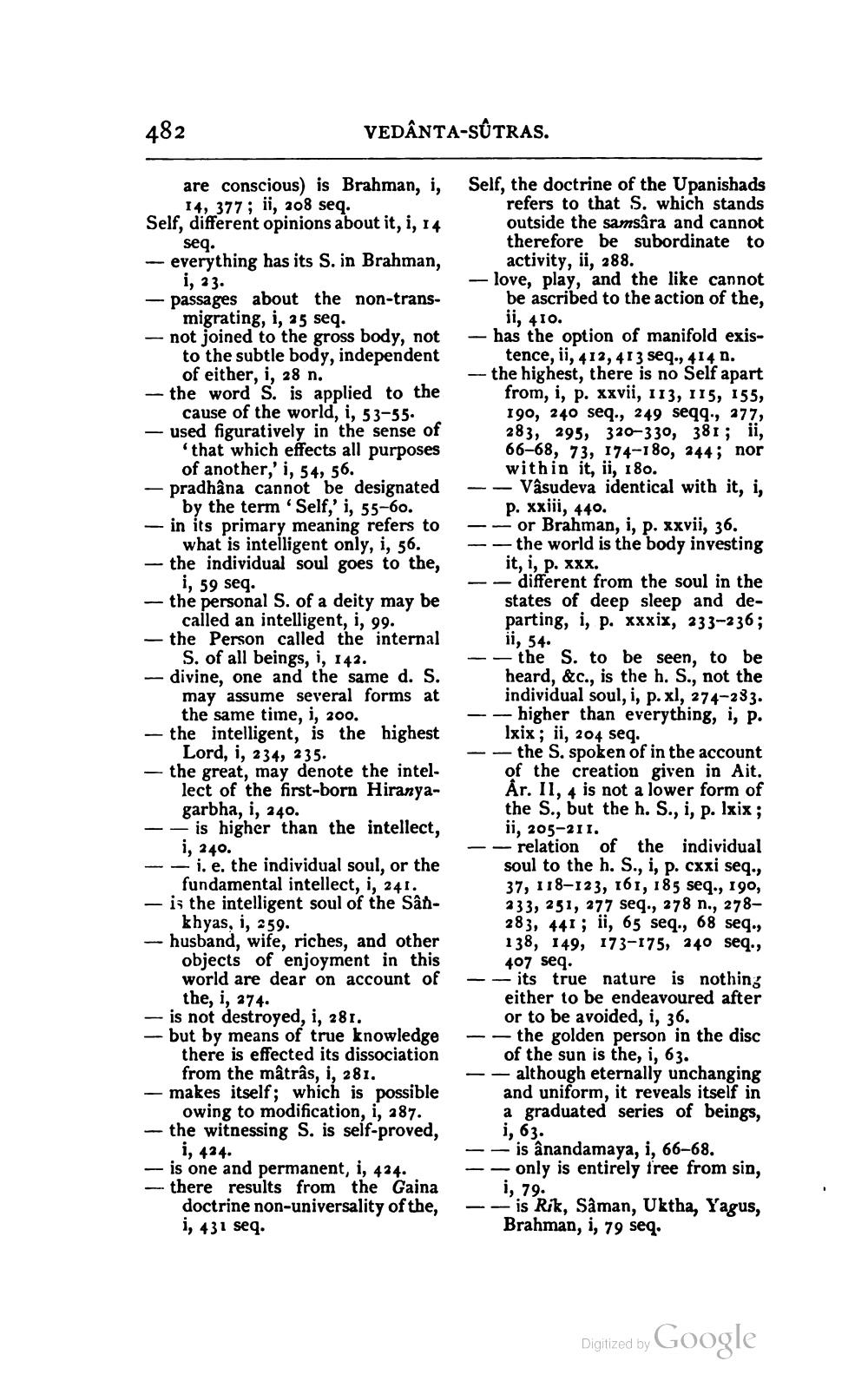________________
482
VEDÂNTA-SÛTRAS.
are conscious) is Brahman, i,
14, 377; ii, 208 seq. Self, different opinions about it, i, 14
seq. - everything has its S. in Brahman,
i, 23. - passages about the non-trans
migrating, i, 25 seq. - not joined to the gross body, not
to the subtle body, independent
of either, i, 28 n. - the word S. is applied to the
cause of the world, i, 53-55. - used figuratively in the sense of
'that which effects all purposes
of another,'i, 54, 56. - pradhâna cannot be designated
by the term 'Self,' i, 55-60. in its primary meaning refers to
what is intelligent only, i, 56. - the individual soul goes to the,
i, 59 seq. - the personal S. of a deity may be
called an intelligent, i, 99. - the Person called the internal
S. of all beings, i, 142. - divine, one and the same d. S.
may assume several forms at
the same time, i, 200. - the intelligent, is the highest
Lord, i, 234, 235. - the great, may denote the intel.
lect of the first-born Hiranya
garbha, i, 240. - - is higher than the intellect,
i, 240. - - i.e. the individual soul, or the
fundamental intellect, i, 241. - is the intelligent soul of the Sân
khyas, i, 259. husband, wife, riches, and other
objects of enjoyment in this world are dear on account of
the, i, 274. - is not destroyed, i, 281. -- but by means of true knowledge
there is effected its dissociation
from the mâtrâs, i, 281. - makes itself; which is possible
owing to modification, i, 287. - the witnessing S. is self-proved,
i, 424. is one and permanent, i, 424. - there results from the Gaina
doctrine non-universality of the, i, 431 seq.
Self, the doctrine of the Upanishads
refers to that S. which stands outside the samsara and cannot therefore be subordinate to
activity, ii, 288. – love, play, and the like cannot
be ascribed to the action of the,
ii, 410. - has the option of manifold exis
tence, ii, 412,413 seq., 4140. -- the highest, there is no Self apart
from, i, p. xxvii, 113, 115, 155, 190, 240 seq., 249 seqq., 277, 283, 295, 320-330, 381; ii, 66-68, 73, 174-180, 244; nor
within it, ii, 18o. - - Vasudeva identical with it, i,
P. xxiii, 440. -- or Brahman, i, p. xxvii, 36. -- the world is the body investing
it, i, p. xxx. - - different from the soul in the
states of deep sleep and departing, i, p. xxxix, 233-236;
ii, 54. -- the S. to be seen, to be
heard, &c., is the h. S., not the
individual soul, i, p. xl, 274-233. --- higher than everything, i, p.
Ixix ; ii, 204 seq. -- the S, spoken of in the account
of the creation given in Ait. Ar. II, 4 is not a lower form of the S., but the h. S., i, p. Ixix;
ii, 205-211. -- relation of the individual
soul to the h. S., i, p. cxxi seq., 37, 118-123, 161, 185 seq., 190, 233, 251, 277 seq., 278 n., 278– 283, 441; ii, 65 seq., 68 seq., 138, 149, 173-175, 240 seq.,
407 seq. - - its true nature is nothing
either to be endeavoured after
or to be avoided, i, 36. -- the golden person in the disc
of the sun is the, i, 63. -- although eternally unchanging
and uniform, it reveals itself in a graduated series of beings,
i, 63. -- is anandamaya, i, 66-68.
- only is entirely free from sin,
i, 79. -- is Rik, Sâman, Uktha, Yagus,
Brahman, i, 79 seq.
Listheas, imite, Fiorme
Digitized by
Digized by Google




